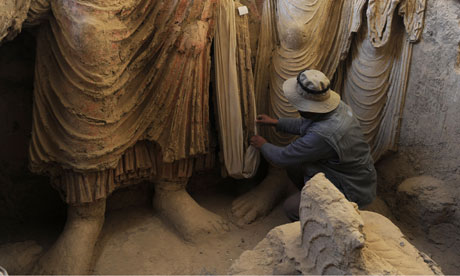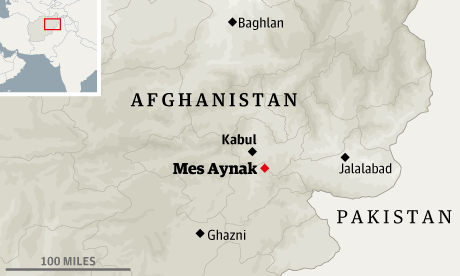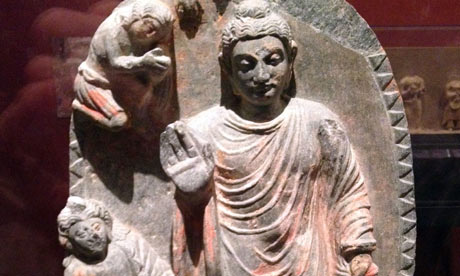Afghan mine delays at ancient site delight archaeologists
Renegotiation of contract with Chinese company mean more time for dig at former Buddhist settlement

An archaeologist looks at the remains of Buddha statues discovered inside an ancient monastery in Mes Aynak. Photograph: Shah Marai/AFP/Getty Images
The forts and temples of the ancient Buddhist town at Mes Aynak inAfghanistan throng with the biggest crowds they have seen in more than 14 centuries. Nearby, rows of sheet metal housing built for Chinese miners are almost empty.
Hundreds of archaeologists are working at the site to excavate gilded statues of the Buddha, elaborate stupas that rise from ornately carved floors and delicate frescoes protected by centuries of mud and forgetfulness. The rich vein of copper that once funded Mes Aynak's creation is now likely to bring about its destruction: a Chinese state-owned mining company paid $3bn (£1.9bn) for the extraction rights, and the site will eventually become the world's biggest copper mine.
But while the fevered excavations are a thrilling sight for those racing to save the last traces of Mes Aynak, the lack of activity in the mining camp is alarming financial mandarins in Kabul, who are counting on mining revenue to make up for slowing streams of western aid.
This year was supposed to see production of the first copper from the site since Afghanistan embraced Islam, the first gush of ore eventually forecast to bring $300m to the government each year, and a $1bn annual boost to the still feeble Afghan economy.
Instead, the only excavation on the site is of archaeological treasures and even the most optimistic officials and analysts admit it will be two years before Mes Aynak copper is trucked off to a Pakistani port.
However, others think 2016 or 2017 are more realistic, after a series of setbacks. The Chinese camp was evacuated last summer after a Taliban rocket attack and shows no signs of being restaffed, the ministry of mines wants to renegotiate the multibillion-dollar contract for the site, and the archaeological dig that must be completed before mining startsis still in full swing.
"Don't worry, you will have at least until 2014," one of the few Chinese miners who stayed on told archaeologists earlier this year. Others fromChina Metallurgical Group (MCC), the company with a majority stake in the mine, had a similar message. "The cultural artefacts are the most important thing," they told surprised workers on an impromptu tour of the dig site.
Nearby, mining equipment sits idle, and many of the watchtowers ringing the core of the mine are empty at midday, although there is an outer circle of guards from a special resources protection unit.

Such concern for another country's cultural heritage, unusual for a hard-nosed Chinese natural resources company, comes as Afghanistan braces itself for huge political and security upheaval in 2014. The last Nato troops will leave by the end of the year, and the country must hold a presidential election to replace Hamid Karzai, who has ruled for more than a decade but is barred by the constitution from standing again.
Any company looking at a decades-long project might prefer to wait for more clarity on who will rule the country, and how secure it will be, before starting work in earnest, although MCC did not respond to requests for comment on its plans for Mes Aynak.
The Afghan government may also be willing to swallow some delays as it looks to renegotiate a contract that has been shadowed by corruption allegations since it was signed off six years ago. The minister who agreed it resigned shortly after reports surfaced that he had pocketed a $30m bribe from MCC, which he strongly denied. .
"We have requested for the renegotiation [of the contract]," said the current minister of mines, Wahidullah Shahrani, who has led a high-profile campaign to modernise the ministry and make its bidding process professional and transparent.
He declined to go into details on what changes he was seeking, saying only that the contract was several years old. "When it comes to these types of big projects, there could be a need for some type of what we call correction measures to be taken. But as of now we have not launched any formal renegotiation with them," he said, in an office lined with samples of the country's many valuable rocks, from lapis lazuli to iron ore.
The Chinese company was due to submit a new work schedule at the end of April, Shahrani said, and if work goes smoothly he believes production could start by 2015.
The cash is certainly needed, with World Bank forecasts for a $7bn hole in Afghanistan's annual budget after 2014, and the wider economy also suffering as US and Nato contracts dry up.
"When Aynak reaches full production the revenues to the government would be at least $300m … although it depends on fluctuations in the international copper market," Shahrani said. "In terms of its contribution to the national economy, the indirect contribution, it would be around $1bn."
But mining experts say that even if preparation work were to start in earnest this June, when the archaeologists' permission to dig ends, production is unlikely before 2016, given the preparation work usually needed for big mining projects.
"Big mines take on average between three to five years to build and construct," said a World Bank mining specialist, Michael Stanley, who declined to comment directly on Mes Aynak.
However, as long as the project is not called off, the wider Afghan economy will benefit from trucking, construction and any other work MCC contracts out, long before copper sales bring the government cash to balance its books.
"What everyone tends to forget is that the construction period for a mine, in terms of economic stimulus, is as important or more for the local economy than the production period," Stanley said.
Mes Aynak highlights Afghanistan's dilemma over protecting heritage
Quest for copper riches in Mes Aynak develops as battle between culture and commerce

Artefacts such as a Buddhist sculpture have been extracted from the Mes Aynak archaeology site where miners want to extract rich deposits of copper. Photograph: Jay Price/Getty Images
The ruins of Mes Aynak straddle a copper deposit so rich that many of the rocks are brilliant green with oxidised ore from a seam of metal first exploited 5,000 years ago.
The remaining copper cannot be extracted without destroying not just the ruins but the entire hill they perch on, and efforts to develop the mine have often been cast as a battle between the heartless miners and valiant archaeologists, racing against time to save their heritage.
The Alliance for the Restoration of Cultural Heritage (Arch), a US non-profit organisation, has led a publicity campaign to prevent the mine, as currently envisaged, from going ahead. It has been so successful that the World Bank office in Kabul faces an internal investigation for supporting the dig and the mine development.
But none of Arch's four directors have a background in cultural heritage, and several have connections to US mining companies interested in Afghan contracts. They are Zalmay Khalilzad, a former US ambassador to Afghanistan, his wife, his business associate in the lobbying firm Gryphon Partners, and a well-travelled restaurateur.
Khalilzad has been openlycritical of China's mining companies and a bidding system that he argues favours them in Afghanistan, the country where he was born and later returned as the first US ambassador after the fall of the Taliban. "The performance of Chinese companies is improving but they have a long way to go," he wrote in a 2011 opinion article for Foreign Policy entitled How many ways can we lose in Afghanistan, which criticised Chinese firms on issues including protection of cultural heritage. "It is certainly ironic that Chinese firms are at an advantage over western companies due to defence department procedures," he wrote, before ending on a slightly less gloomy note: "It is not inevitable that Afghanistan's valuable resources fall into the hands of the Chinese."
Afghan archeologists and experts working on mining have a more complex view of the mine's impact than Arch. Abdul Qadir Temori, head of the Afghan Institute of Archeology, who has committed his entire team of more than 30 graduate archaeologists to Mes Aynak, says the site is so complex and fascinating that experts could easily spend two decades picking over it.
In an ideal world that would be the case, he says. But Afghanistan is desperately poor and has suffered 30 years of violence, which means leaving artefacts in the ground offers little guarantee of preservation.Desperation and lawlessness have fuelled a ruthlessly efficient looting industry, and before the mining guards sealed off the site, looters stripped Mes Aynak of treasures that had been buried untouched for centuries, and destroyed beautiful buildings and crucial archeological evidence in the process. Just a few dozen miles away is Kharwar, another ancient site that may be even richer in remains, but has been described by the UN as "in danger of complete destruction". Without security or funds for excavation, only looters are picking through its treasures.
"Kharwar is possibly more beautiful than Mes Aynak, almost the same age," said SM Raheen, the minister of culture and information. "Unfortunately looting is going on there, but no one pays any attention … I don't know why everybody cares just about Mes Aynak."
The mine will ultimately destroy Mes Aynak, but it may also save it from leaving no record or legacy. The urgent need to salvage the site has brought an influx of funds for archaeologists, creating probably the biggest excavation project the country has seen and plans for a storage site for the treasures that are dug up, either in Kabul or near the mine.
The expensive, and extensive mine security has allowed work to go ahead in an area that would otherwise be largely controlled by the Taliban, more famous for blowing up the great Buddhas of Bamiyan than supporting cultural projects.
Archaeologists working on the ancient Afghan town, and the spectacular Buddhist temples around the settlements and smelters, are quietly confident they can rescue the majority of its treasures before it vanishes. Experts discuss stabilising foam, steel reinforcements and the merits of plucking stupas out whole or painstakingly dismantling them stone by stone, then rebuilding them in a permanent museum. "When thieves target a site, they destroy 10 pieces to steal two pieces," Raheen added when asked about the mine and its impact. "This project has been helpful, to save the site. Otherwise it would face the same fate as Kharwar."
No comments:
Post a Comment